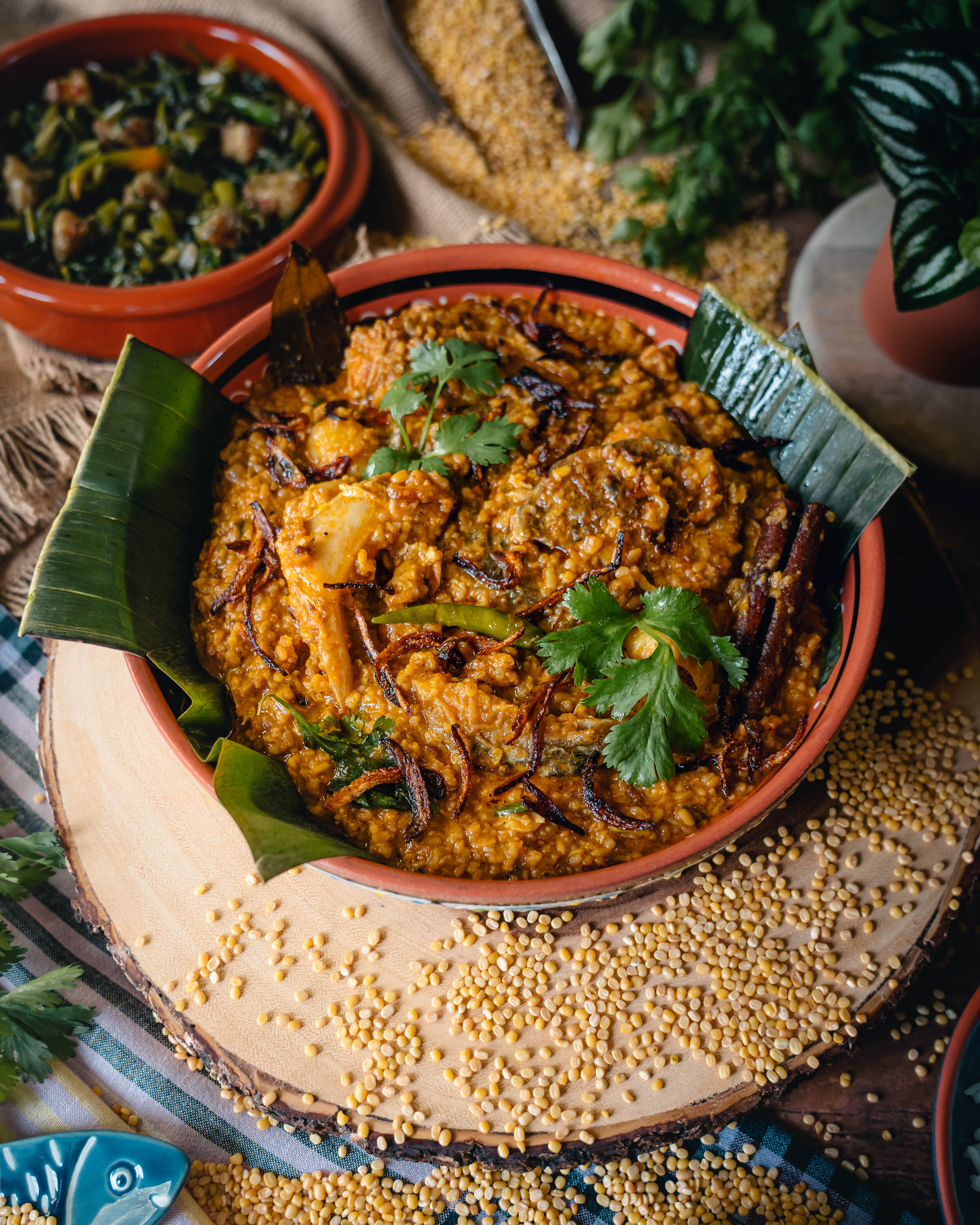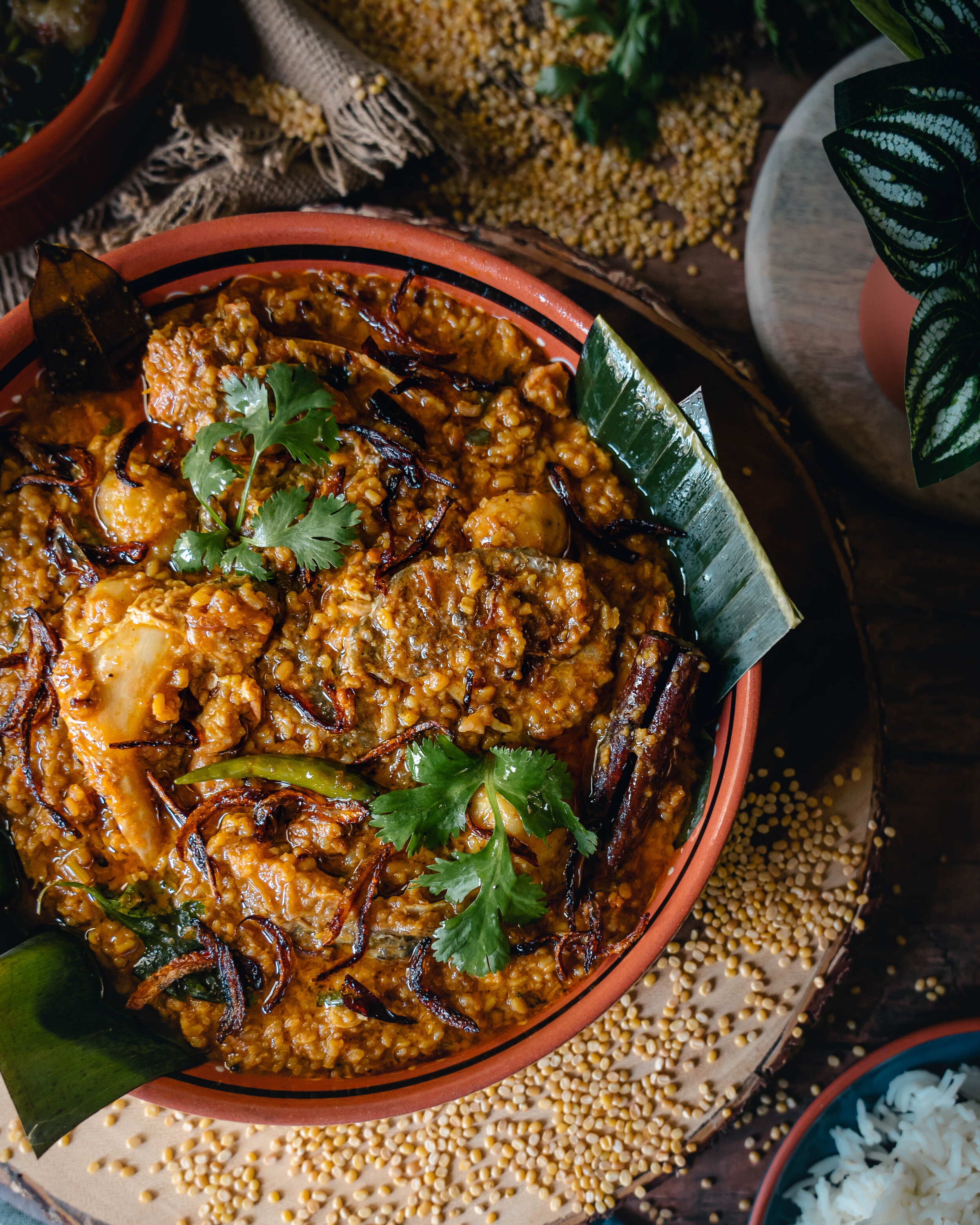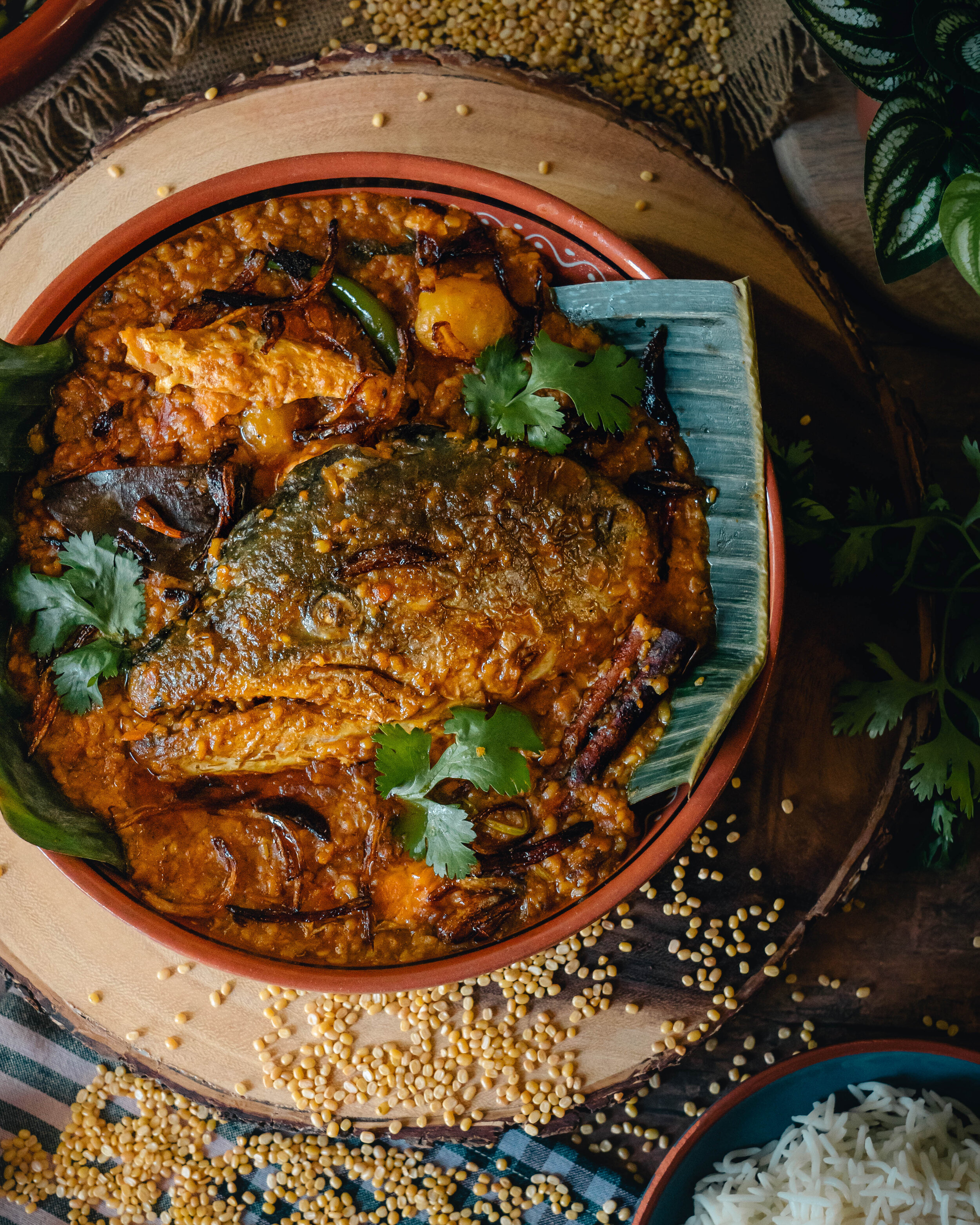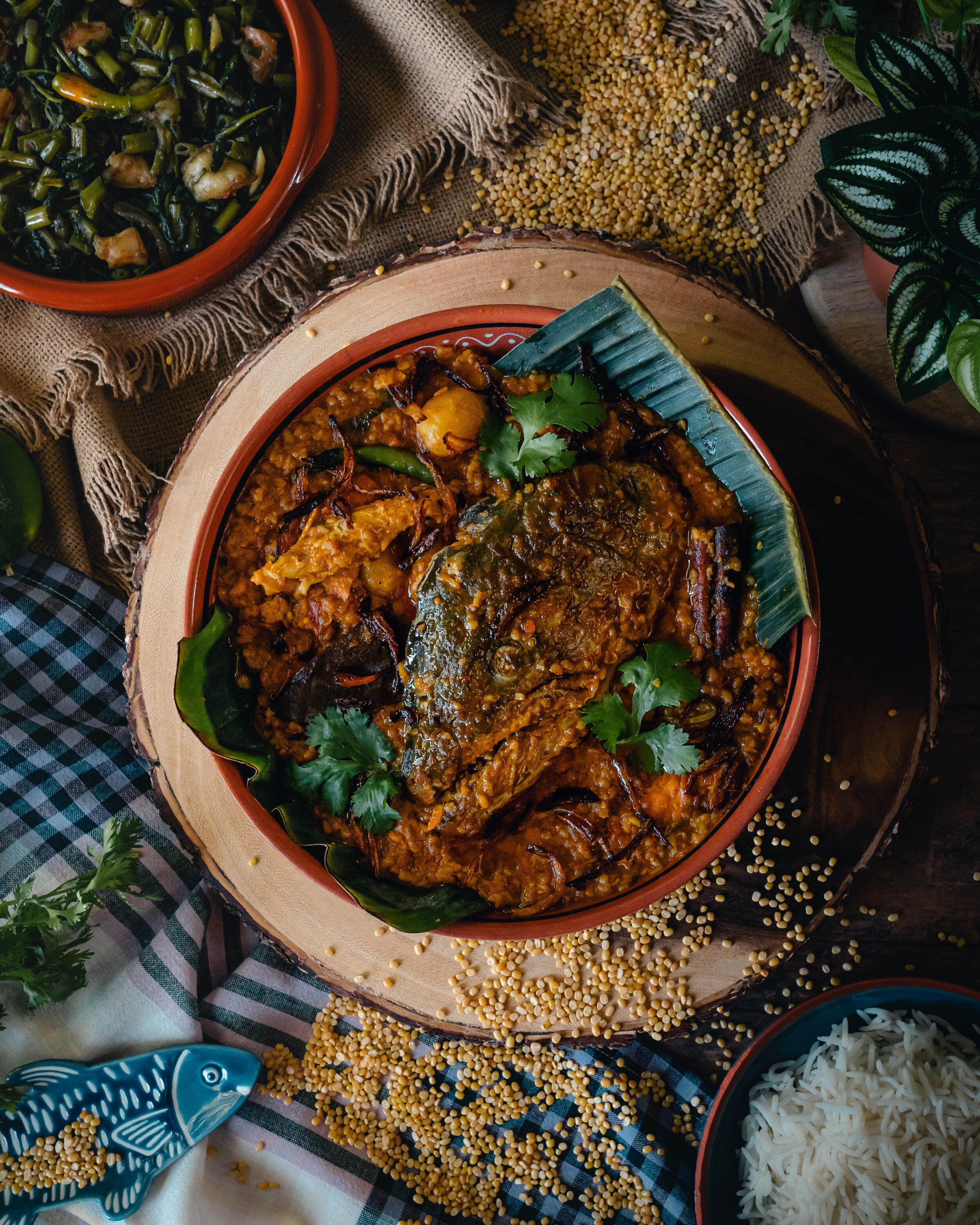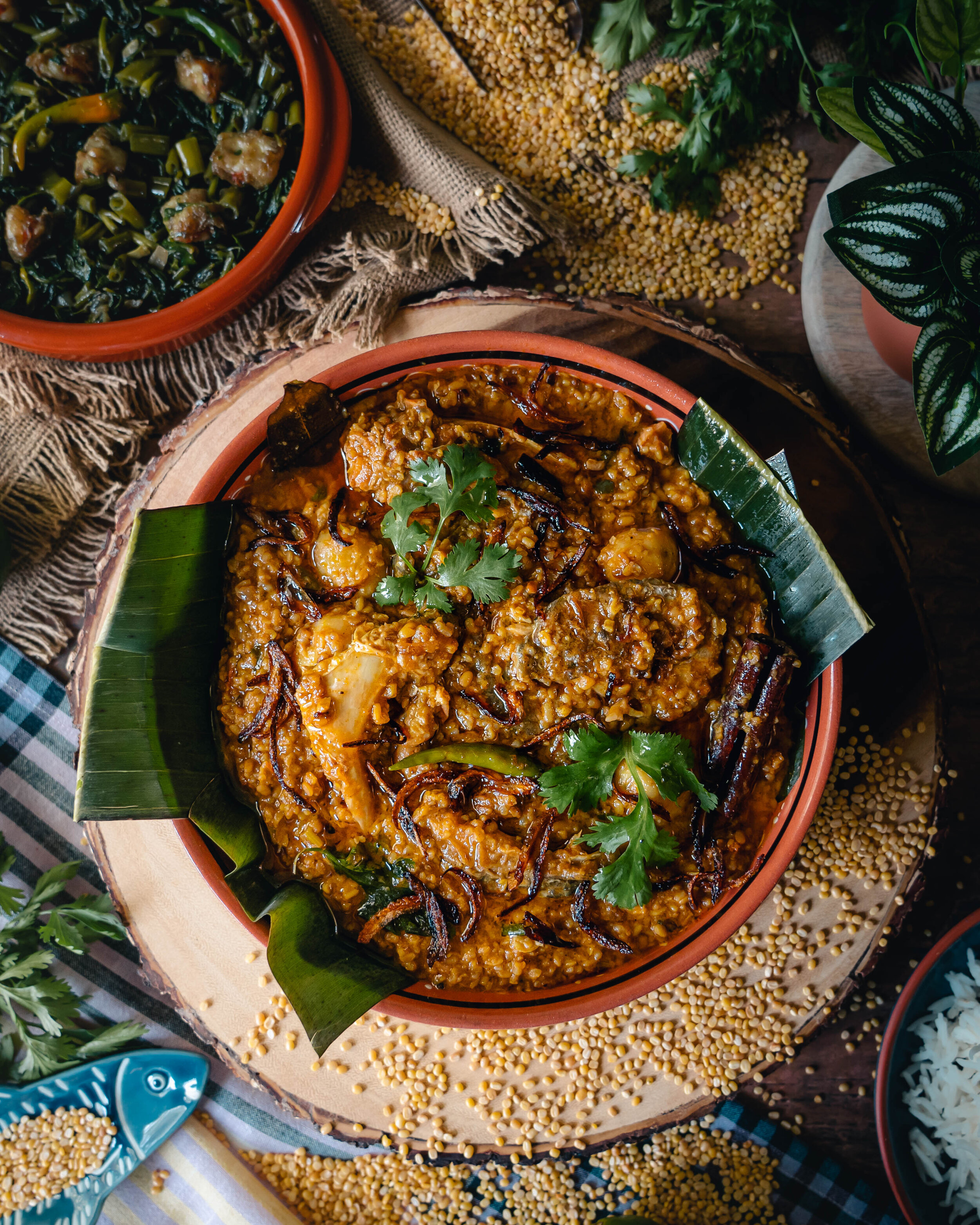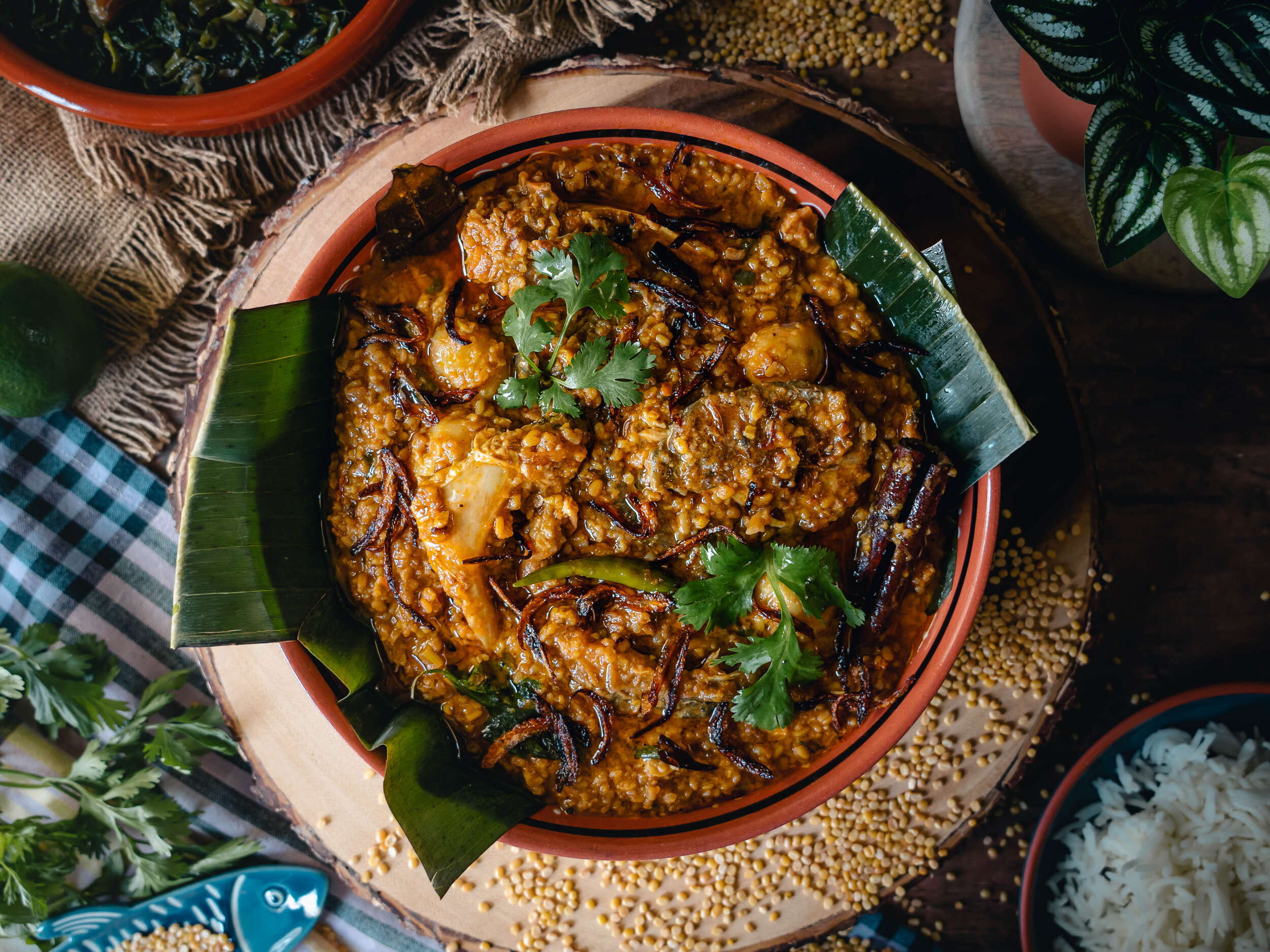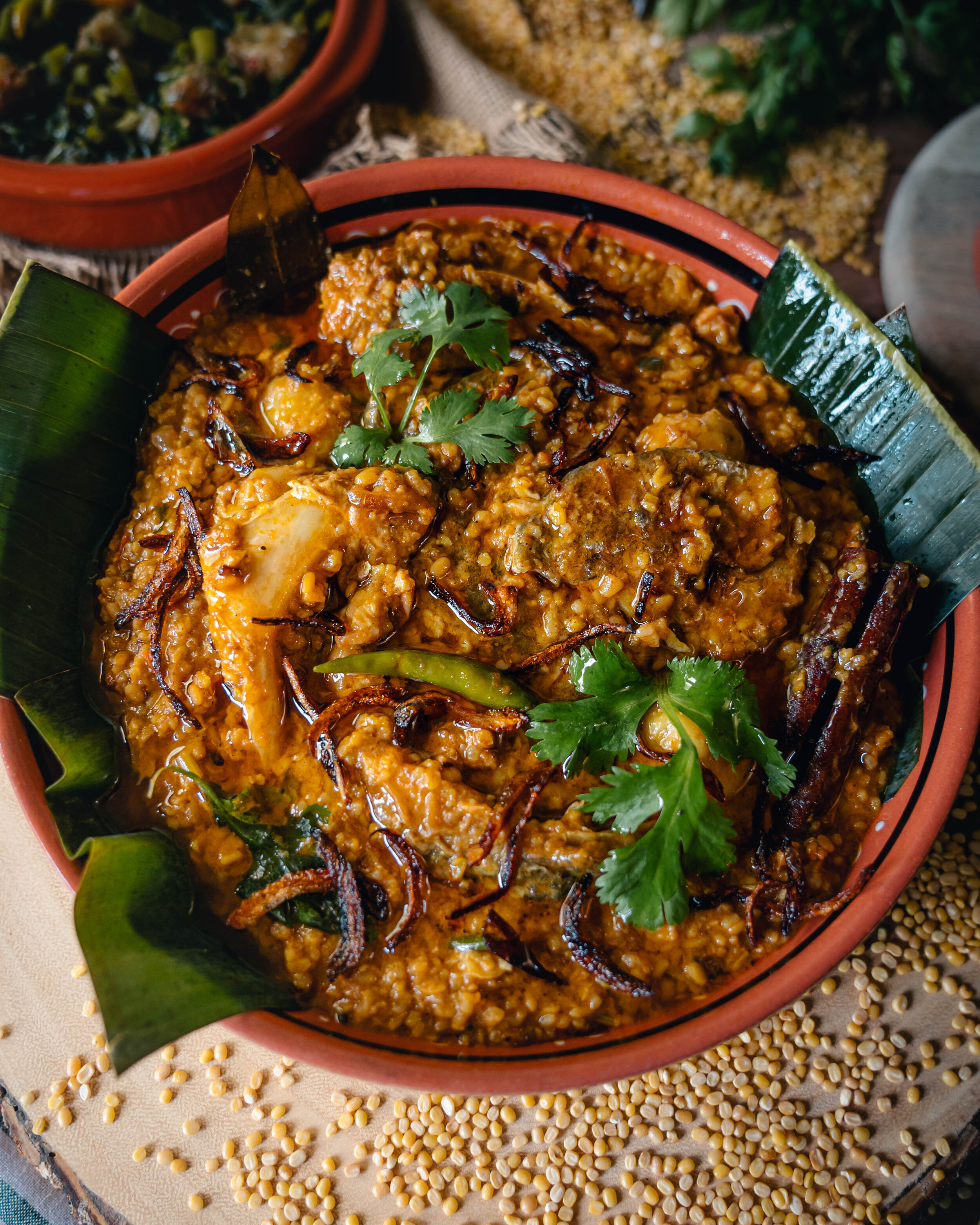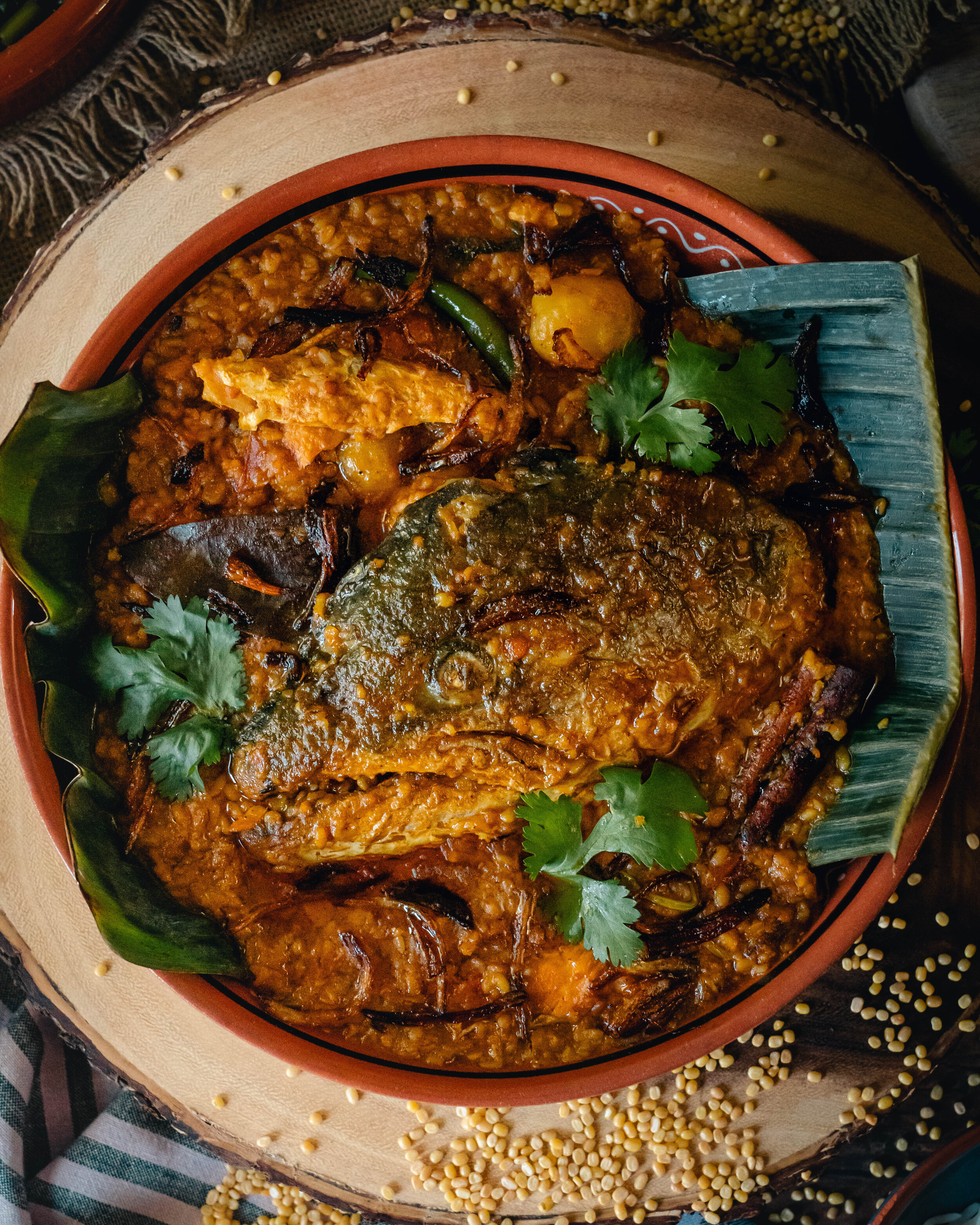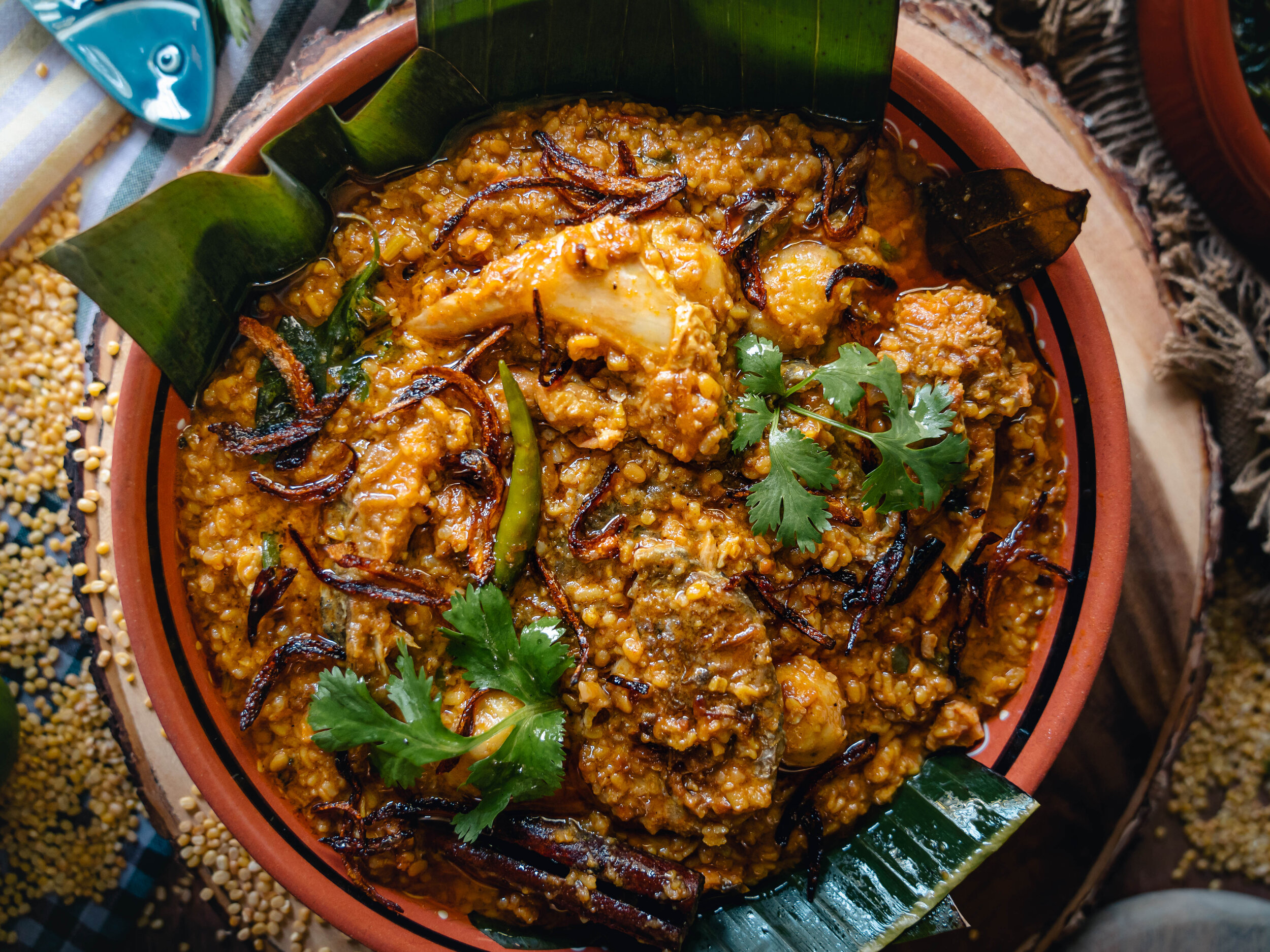Muri Ghonto
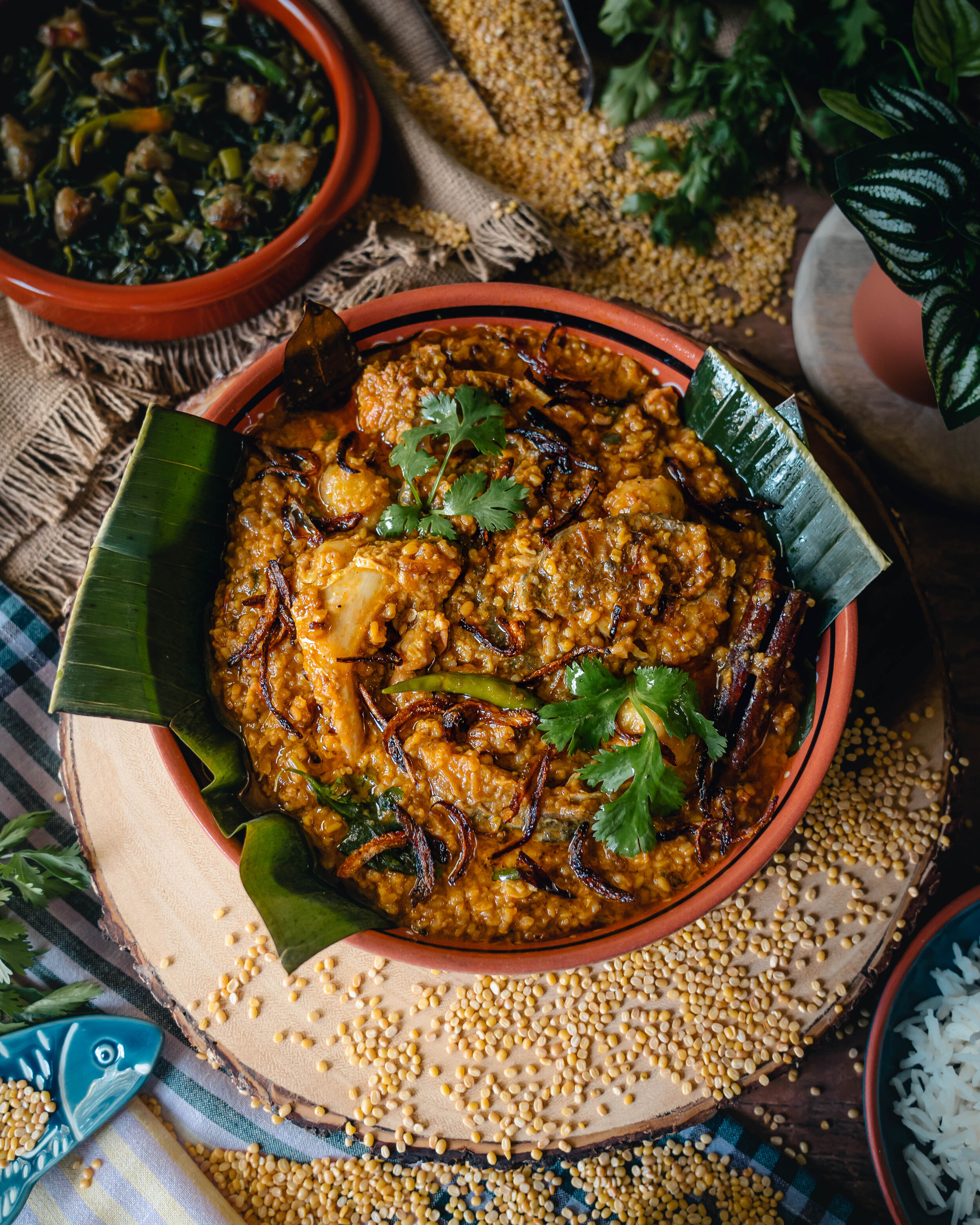
Muri Ghonto — a signature dish in Bengali cuisine which originated in the land of rivers during the early days of the ancient trade routes. In essence, it is a spicy fish head stew cooked with fragrant lentils or rice and slowly braised in a melange of spices and aromatics. It is very special to Bengalis both in Bangladesh and West Bengal.
The Bangladeshi Muri Ghonto is a rich and unctuous fish head and lentil stew made with large freshwater fish and mung bean lentils. If you haven’t had this Bengali delicacy yet, or some variations of it, are you even Bengali? Whether you are Bengali or not, fret not my friends! This is where I come in and offer up my wisdom, origin stories of this beloved dish along with my tried and true recipes.
Etymology
The word muri (not to be confused with puffed rice) derives from the Bengali word muro which means head or in this case fish heads! Ghonto is a culinary term, a cooking process in Bengali cuisine which literally means a mixture of everything, a mish-mash you could say.
Two Versions
Although there are many regional variations, the two main versions from Bangladesh and West Bengal, India are both similar and distinct from one another. They are similar because traditionally we always use large freshwater fish like Rohu or Catla — carp fishes that are native to South Asia. But the two variations are distinct from one another because of the type of grains used to braise the fish heads.
The Bangladeshi Muri Ghonto uses moong dal as in mung bean lentils which makes it a spicy lentil stew or a curry. The West Bengal version of Muri Ghonto uses aromatic rice like gobindobhog, kalijeera or basmati, which makes it more of a spicy rice pilaf with fish heads, kind of like a paella. Regardless of the grains used, one thing is for certain, this dish is an acquired taste because of use of fish heads. But once you have crossed that barrier, muri ghonto is comforting and addictive.
Origin
According to food historians, Muri Ghonto is a very ancient dish, possibly going back to the days of the Ganga Dynasty which reigned from Kalinga from the 5th century to the early 15th century. Kalinga was the larger historical region in ancient India which encompassed a big part of the modern day Indian state of Odisha and North-eastern part of the state Andhra Pradesh. Kalingapatnam was an ancient port city in the region of Kalinga, which was also part of the ancient trade route as it was situated near the Bay of Bengal.
At it’s height, it was a flourishing seaport with vessels full of silk and spices that sailed from Kalinga to Burma, Ceylon, Java, Sumatra, Malay, China and many other countries. The cultural milieu of these ancient times is still reflected in the language, literature, cuisines, art and religion of eastern Indian subcontinent and South East Asian countries. If you read our post on Chingri Malaikari, you will know exactly what I am talking about.
Just like the Chingri Malaikari, the precursor dish to Muri Ghonto was also said to have originated during the early days of the Silk Route near the ports of this ancient city of Kalingapatnam. The precursor version of Muri Ghonto is very different from it’s modern day form. The original dish was more of a fish broth, made of leftover fish tails and heads which was cooked in a stock seasoned with salt, turmeric, ginger and bayleaf. Slightly soupy in texture, it was a hearty one pot meal for the seafaring traders and merchants arriving and leaving the port.
This ancient dish is also considered to be the hallmark of many coastal dishes that originated in and around these seaports. It’s brilliance not only made it a local favorite meal for the traders and the merchants, but also traveled to different areas along the trade routes and became their own versions and variations. All these different variations are now treated as festive specialties and must have during weddings and grand feasts. But how did a humble fisherman staple become a royal feast highlight? It’s partly due to the traders and merchants, who took the recipe and the cook to their part of the region to create their own version, and partly to the sailors and settlers who introduced it in the ports that they traded in or kingdoms they eventually established.
As this dish made it’s way across the map, native ingredients were added in each localities — in Bengal it was the addition of aromatic rice grains, in Bihar it was moong dal, and in Assam it was vegetables. This ancient dish is even considered the precursor dish to the Persio-Mughal Fish Biryani, given the use of similar spices to give its unique fragrance and charismatic palate — cardamom, bayleaves and garam masala. But it didn’t just stop here in the Indian subcontinent. It managed to make it’s way across to Malay, Java and Sumatra and today the Malay version of this dish is popularly known as the world famous Red Snapper Fish Head Curry.
The Bangladeshi Muri Ghonto I am showcasing today is one of those variations that traveled from Bihar and took hold in Bangladesh. It is that same balance of flavors without the overpowering of spices and aromas which makes this dish such a classic even today. It may look like a mish-mash of fish, grains and vegetables, but in reality it requires a lot of care and mastery to intricately layer the elements and emphasize the hero ingredient: fish head, over the lentils and spices.
Fish Heads!
As I have discussed above, the precursor dish to Muri Ghonto traveled, took hold and evolved into various different versions in different localities. But still there is a lot of aversion to the idea of eating fish heads in the West, the part of the world we live in and more than likely a lot of our readers live in. Although, fish head is assumed to be a delicacy here, it is very common and a regularly consumed ingredient that is loved across so many countries and different continents around the world.
When I started this new series, Bangladesh: Return To Our Roots, my purpose was to try and revive traditional and indigenous foods and recipes of my land. On that same note, this is my attempt to shed light on the abundance of fish head recipes scattered across the globe and debunk this myth of fish heads being an unpalatable ingredient. You are seriously missing out on one of the tastiest, most delicate parts of the fish and the rest of the world agrees with me as well!
Fish Head Based Dishes Around The World
Kari Kepala Ikan | Malaysia, Indonesia, Singapore
A Malay dish with mixed Indian and Chinese origins — this is the red snapper fish head curry I mentioned above which is the variation of the precursor dish to Muri Ghonto. The head of a red snapper is stewed in a curry with assorted vegetables such as okra and eggplants. It is usually served with either rice or bread.
Meen Thala Kari | India
A spicy fish head curry originating from Kerala, the Southwestern coast of India. Large fish heads are slowly simmered in a spicy coconut milk gravy which gives the curry a very rich flavor. This dish is said to be really popular in toddy shops, which are drinking establishments that serve palm wine and really spicy fish curries. Again, this is also another variation of the precursor dish that was once found along the seaports of the trade routes.
Shā Guō Yú Tóu | China
Fish head casserole is relished in many regional cuisines in china. The dish itself is named for its main ingredient, yú tóu — fish heads, which are braised in a clay pot or casserole. All over China, people treat it as a festive dish and take their time to eat this delicacy. It is served with freshly baked flatbread which soaks up the collagen-infused gravy.
Bouillabaisse | France
A traditional Provençal fish stew using at least three kinds of fish, shellfish as well as other types of seafood. Certain versions of the bouillabaisse have heads and trimmings of the fish which are slowly simmered together with leeks, onions, celery and various vegetables. It is traditionally served with grilled slices of bread and a special mayonnaise based sauce called rouille.
Fish Tea | Caribbean
A fragrant and spicy broth-based Caribbean fish soup, made with fish heads and bones, hearty veggies, potatoes and various types of seafood. Some believe it to be an aphrodisiac and it is associated with various legends and rumors in the Caribbean countries.
Stargazy Pie | England
Fish pie made with baked sardines, along with eggs and potatoes, covered with a pastry crust. The unique feature of stargazy pie is fish heads (and sometimes tails) protruding through the crust, so that they appear to be gazing skyward.
Crappit Heid | Scotland
A traditional Scots fish course, consisting of a boiled fish head stuffed with oats, suet and liver. The cooked dish is served with potatoes or other root vegetables that are in season.
Caldillo de Congrio | Chile
A traditional Chilean fish stew dish which is made by boiling together fish heads, onion, garlic, coriander, carrots and pepper. Once these are boiled, only the stock is used.
Cabeça de Peixe | Portugal
A popular snack made with whole fish heads which are braised, grilled, and made into a spread. The Portuguese fondness for fish heads also profoundly influenced the food traditions in its former colonies. On India’s Goa coast, for example, Portuguese fish head soup seasoned with turmeric and coriander is regularly made in homes and restaurants.
Kibbeling | Netherlands, Norway
A popular snack in many Northern European countries. Cod cheeks and tongues are dredged in a well-seasoned batter and fried in large quantities of oil, then it’s smeared with garlicky mayonnaise or tangy tartar sauce.
Gumbo | West Africa
Although it is known as a Southern favorite dish with a smoky fish base in the USA, the original dish is a traditional fish heads and okra stew and did not contain any pork based products. This dish traveled to Louisiana from West Africa and evolved into what we know as gumbo today.
Rosh Hashanah I Jewish Communities around the World
In some Jewish communities, it is traditional to eat a fish head for new year celebration. Rosh Hashana which literally means "head of the year" is a religious holiday that marks New Year in the Jewish calendar. The fish head can be prepared in many different ways, depending on which country the Jewish community is in. For example, Sephardic Jews in Morocco have a specialty dish called Chraime — a whole fish cooked in a spicy tomato sauce, taking special care of the fish heads.
In fact, there are plenty more fish head based dishes that I did not cover here today but if you want to learn more, google is your friend!
Recipe — Muri Ghonto
Fish Head Stew with Lentils
Serves: 4-6
Preparing the Grains
Moong Dal - 1 ½ cup
Heat a cast iron skillet or a thick bottomed wok over medium heat. Dry roast the Moong Dal while continuously stirring. Once the dal has changed color from yellow to a golden brown, remove it from the heat. Transfer it to a pot and wash with cold water to stop the cooking/roasting process. Wash the roasted dal really well and drain the water.
Warm Water - 3 cups
Salt - ½ tbsp
Soak the dal in warm water and salt for 30 minutes. This is a process of hydration, where soaking in warm water and salt without the aggression of excessive heat, will result in fluffy and distinct grains in the finished dish.
Rice - ¼ cup, Kalijeera or Basmati
Warm Water - 1 cup
Soak the rice in warm water for 30 minutes.
Note: This is an optional step. It’s not very common to add rice in a Bangladeshi style Muri Ghonto. It is however a trick that’s used in certain regions of the country, mainly in the north — an area which is also adjacent to Indian state of Odisha, Bihar, and West Bengal from where Muri Ghonto originally comes from. The purpose of the rice is to add a bit of starch to thicken the gravy in the finished dish. Also the use of aromatic rice like Kalijeera or Basmati will add a nice fragrant finish to the dish as well. If you like the gravy of your fish stew to be more runny, then omit this step altogether.
Preparing the Fish
Fish Head - 1-2 | **also tails and any uneven pieces (see note)
Salt - 1 tsp
Turmeric - ½ tsp
Red Chili Powder - 1 tsp
Oil - 1 tbsp (for marinade)
Oil - ¼ cup (for frying)
Wash and pat dry the fish. Marinate the cleaned fish head and other pieces with salt, turmeric, red chili powder and a little bit of oil. Set aside for about 15 minutes. Heat oil in a sauté pan over low heat and fry the fish pieces until well browned on all sides. Set aside the fried fish pieces on a plate.
Note: In Bangladesh and West Bengal, the main ingredient for Muri Ghonto is large Carp fish like Rohu/Rui and Katla/Catla. Carps are not native to North American waters, but various carp species have been introduced here over the years. You may get lucky and find some Rui or Katla at your local Bengali groceries, but the downside is that it will be frozen. Or you could find some fresh Asian carp like Bighead or Silverfin at your local Asian groceries. Alternatively, you could also use Snapper, Trout, Tilapia or Salmon like I have. I was really hoping for a cute looking carp but I got stuck with a giant alpha salmon. Oh well!
Now if you haven’t read anything I wrote above, I am going to repeat myself — this recipe is traditionally made with fish heads. But for the sake of not wasting food, I like to include fish tails and any uneven pieces that would be otherwise discarded, just like the precursor dish.
I am very much aware that a lot of people may still be averse to the idea of eating fish heads, even after all my attempts at coaxing and convincing. If that’s the case, you can make this with bone-in fish steaks or boneless fish fillets as well. Just make sure to handle the fillets more gently since they are more delicate than the heads and bones. It will be less flavorful and you will miss out on the rich collagen infused stew which comes from the usage of fish heads.
Preparing the Maśalā
Oil - ¼ cup
Bay Leaves - 2
Cinnamon - 2-4
Cardamom - 4-5
Clove - 4
Whole Black Pepper - 7-8
Dried Red Chilies - 2
Use the same sauté pan with the leftover oil from frying the fish. Turn it to medium heat, and add ¼ cup oil. Once the oil seems hot, temper the whole spices, making sure not to burn them, about 1-2 minutes.
Onions - ¼ cup, diced
Onion Paste - ¼ cup
Garlic Paste - 1 tbsp
Ginger Paste - 1 tbsp
Red Chili Powder - 1 tbsp
Turmeric - ½ tsp
Coriander - 1 tbsp
Cumin - 1 tbsp
Add the diced onion and fry until golden, about 5 minutes. Then add all the aromatic pastes and the spices. Add a splash of hot water if needed so the dry spices don’t end up burning. Fry the aromatics and spices until the raw smell are gone and oil starts to pool on the sides.
Green Chilies - 4, bruised
Fresh Coriander Stalks - ¼ cup, chopped
Tomato - ¼ cup, chopped
Once the raw smell from the onion, garlic and ginger has completely dissipated, add the green chilies, coriander stalks and tomatoes. Add a splash of hot water if needed, to ensure the gravy doesn’t catch at the bottom and burn. Continue sautéing until the water from the tomato has evaporated and the oil starts to separate and pool on the side. The moshla (in Bengali) aka maśalā which is the base of the stew is now ready.
Bringing It All Together
Soaked Grains - Moong Dal and Rice (if using)
Salt - 1 tsp
Drain the soaking water from the grains, add them to the sauté pan. Add salt, then combine the lentils and rice with the masala base we prepared earlier. Continue braising the lentils, stirring frequently. Again, add a splash of hot water if needed, to ensure the lentil doesn’t catch at the bottom and burn. Continue sautéing for another 7 to 8 minutes.
Hot Water - 1 cup
Add hot water, combine with the lentils and cover the lid. The lentil will cook until the water is fully evaporated, but make sure to stir in between. Once the water is completely absorbed, it is now time to add the fish.
Fried Fish Pieces
Add the fried fish pieces and braise with the dal, about 5 minutes.
Hot Water - 1 ½ cup, you may add more or less depending on how thick or thin you prefer the fish stew
Add the hot water, mix everything, cover the lid and simmer in medium-low heat for 20 to 30 minutes, until the dal is cooked but still holds shape.
Roasted Cumin Powder - 2 tsp
Ghee - 1 tbsp
Coriander Leaves - ¼ cup, chopped
Fried Onions (Bereshta) - ¼ cup
Green Chilies - 2
Turn off the heat. Finish with roasted cumin powder, ghee, coriander leaves, fried onions, and slit green chilli. Give it one final stir, cover tightly with a lid and rest for 15 minutes before serving.
Serve it with steamed rice, Bangladeshi style stir fried greens, fried vegetables or vegetable curry like the Panch Mishali Shobji.
If you do recreate our recipe, be sure to
TAG & FOLLOW @TheSpiceOdyssey
Stay up to date with us on on Instagram, Pinterest, Youtube and Facebook.
